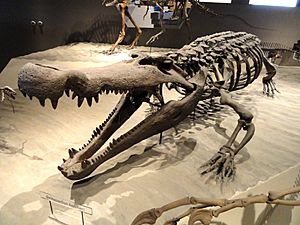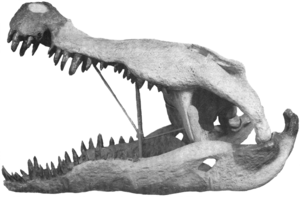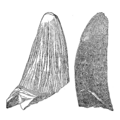Deinosuchus facts for kids
Quick facts for kids DeinosuchusTemporal range: Upper Cretaceous
|
|
|---|---|
 |
|
| Reconstructed skeleton at the Natural History Museum of Utah | |
| Scientific classification | |
| Kingdom: | |
| Class: | |
| Infraclass: | |
| Order: | |
| Suborder: |
Eusuchia
|
| Superfamily: |
Alligatoroidea
|
| Genus: |
†Deinosuchus
Holland, 1909
|
Deinosuchus was a giant, extinct relative of today's alligators. It lived about 80 to 73 million years ago during the Upper Cretaceous period. Imagine an alligator the size of a school bus!
The first pieces of Deinosuchus were found in North Carolina in the 1850s. However, it wasn't until 1909 that this amazing creature got its official name and description. More fossils were found in the 1940s. These helped create a skull model at the American Museum of Natural History, though it wasn't perfectly accurate. Scientists are still learning more about Deinosuchus as new skull parts are discovered.
Contents
Meet the Giant Alligator Relative
Deinosuchus was much bigger than any crocodile or alligator alive today. It could grow up to 12 m (39 ft) long. That's like four cars lined up end-to-end! It also weighed a massive 8.5 metric tons (9.4 short tons). Even with its huge size, it looked quite similar to modern alligators.
What Did Deinosuchus Look Like?
This ancient reptile had very large, strong teeth. These teeth were perfect for crushing things. Its back was covered with thick, round bony plates. These plates are called osteoderms and would have offered great protection.
How Long Did It Live?
Scientists believe Deinosuchus might have lived for up to 50 years. It grew at a similar speed to modern crocodilians. However, it kept growing for a much longer time, which explains its enormous size.
Where Did Deinosuchus Live and Hunt?
Fossils of Deinosuchus have been found in ten different U.S. states. They have also been discovered in northern Mexico. This means it lived across a wide area of ancient North America.
Its Ancient Home
Deinosuchus lived on both sides of the Western Interior Seaway. This was a large, shallow sea that once split North America in two. It was a top apex predator in the coastal areas of eastern North America.
Different Populations
The Deinosuchus found in the western parts of its habitat grew to be the largest. However, there were many more Deinosuchus in the eastern areas. Scientists are still discussing if these two groups were different species.
What Did It Eat?
Deinosuchus was a powerful ambush predator. It likely hid and then surprised its prey. It was probably strong enough to hunt and eat large dinosaurs! It might have also eaten sea turtles, fish, and other animals living in or near the water.
Images for kids
See also
 In Spanish: Deinosuchus para niños
In Spanish: Deinosuchus para niños







